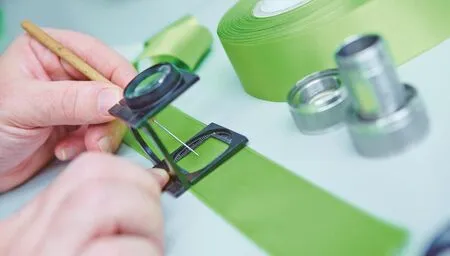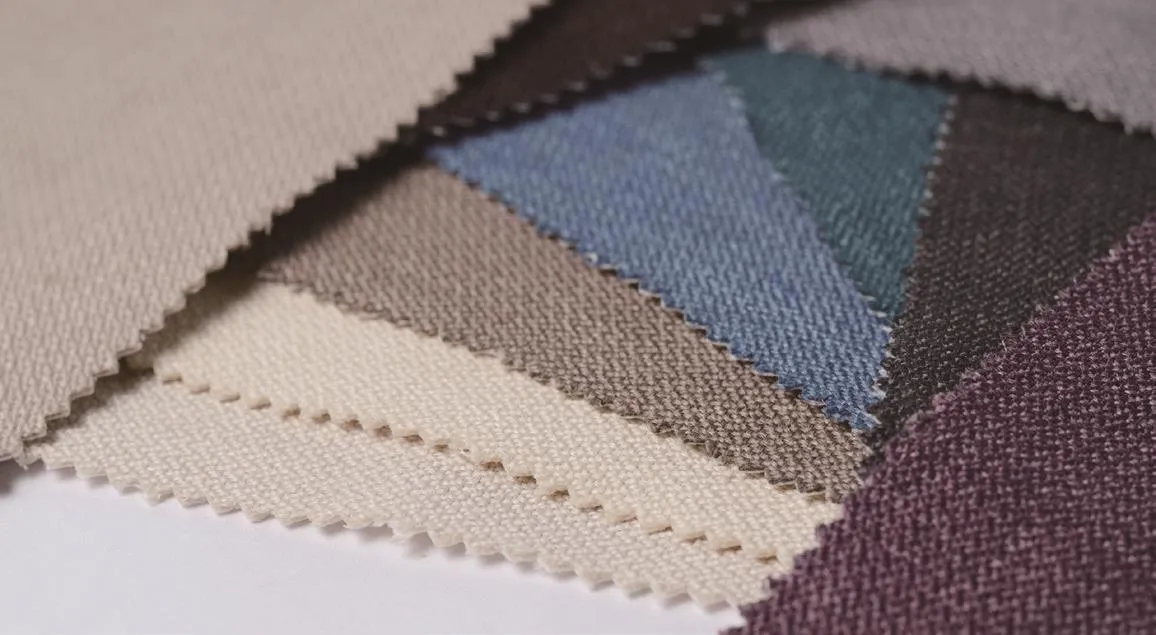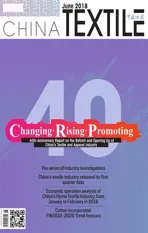Investigation on standards,testing and quality
2018-06-28
On March 13th, the research group led by Li Lingshen, Vice President of China National Textile and Apparel Council (CNTAC), organized the persons in charge of relevant units to hold a symposium with the theme of “Standards, Testing and Quality” in Shanghai. Peng Yanli,Deputy Secretary-general of CNTAC and Director of Ministry of Science and Technology Development, Zhang Huiqin and Sun Ximin, Deputy Directors of Ministry of Science and Technology Development of CNTAC,followed the investigation. The representatives of Shanghai Textile Science Research Institute, Textile Industry Chemical Fiber Standardization Technology Centralized Unit, National Textile Standards Committee Cotton Textile Branch, Printing and Dyeing Products Branch, Woolen Textile Branch, National Garment Standards Committee, National Home Textile Standards Committee Ribbon Branch, K-BOXING Menswear (Shanghai)Co., Ltd., Shanghai Semir Clothing Co., Ltd., Shanghai Threegun (Group)Co., Ltd., Shanghai Hengyuanxiang Garment Co., Ltd., Shanghai Challenge Textile Co., Ltd., Shanghai Textile Group Testing Standard Co.,Ltd., Shanghai Institute of Quality Inspection and Technical Research Institute of Fibre Inspection, Shanghai Intertek Quality Technology Service Co., Ltd., Bureau Veritas Commodity Inspection (Shanghai) Co., Ltd. and other units attended the symposium.
At the symposium, the representatives of various units introduced their experience in carrying out the work of standards, testing and certification and quality, and put forward suggestions on the problems in the implementation of current mandatory national standards, recommended standards, enterprise standards and group standards, as well as the existing problems in the current testing system and market supervision.
There still exist loopholes in the mandatory standards
In recent years, there have frequently appeared the cases that textiles and garments are removed from shelves because they have been found to be unqualified in pH value. In response to this problem, Wang Jianping,Professor-level Senior Engineer of Shanghai Intertek Quality Technology Service Co., Ltd., put forward that, theoretically speaking, the acidity or alkalinity of the water extract liquid of textile products is too high, which may cause dysbacteriosis on the skin surface, but the pH value of the aqueous extract of general textile products is basically kept in a range that is harmless to human body. “Currently, no other country in the world,except China, has adopted the pH value of the water extract liquid as a mandatory assessment item for textile products. Due to the existence of this assessment index, companies suffer a lot of losses, so I call for the cancellation of the index of pH value in national mandatory standards.” Wang Jianping suggested.
Bureau Veritas Commodity Inspection (Shanghai)Co., Ltd. is also one of the third-party testing agencies,the company’s Senior Engineer Gao Ming introduced that, last year, the mandatory national standard GB 5296.4-2012 “Part 4 of Instructions for Use of Consumer Goods: Textiles and Clothing” was officially converted into a recommended standard, which is a great opportunity for enterprises, but since the followup measures have not kept up with it, there exist relatively big loopholes in this standard at present. “This standard currently belongs to recommended standard in China, but the standard corresponding to it internationally is mandatory standard.” Gao Ming listed an example that, in recent years, our country has spent a lot of financial resources and material resources to do statistics of China’s somatic data, which provides the basis for fashion design and plays a good role in guiding industry development. But after the standard is changed into the recommended standard, enterprises can label the clothing size with “S/M/L” according to foreign standards, which causes distress to consumers,so it is recommended to make GB/T 5296.4 mandatory.
Li Tianjian, Deputy General Manager of Shang-hai Threegun (Group) Co., Ltd., also said that in the implementation of national standards, there are often inconsistencies between national standards and relevant regulations. “For example, new national standards do not require to indicate the classification of clothes, but ‘Product Quality Law’ requires to indicate it.” Li Tianjian said.
Cao Xianhua from Woolen Textile Branch of National Textile Standard Committee mentioned that the existing mandatory national standards mainly aim at the restrictions of chemicals, and for physical properties, at present, there are only requirements on the safety of accessories and rope belts in GB 31701, while foreign countries also have stricter mandatory requirements for the products of infants and children, so it is suggested that China also formulate relevant mandatory product standards to prevent similar risks.

Weakening product standards and strengthening basic standards
With the continuously rising consumption level, people’s requirements for textiles and clothing become increasingly diversified, and there is an increasing number of personalized and stylish products on the market, but many products can not enter the market since they are not in line with the standard. “Products are alive while standards are dead.” Wang Jianping suggested that, whether it is the national standard or the industry standard, it is suggested to weaken product standards, strengthen basic standards and act on international convention. Gao Ming also expressed the same view, “the main body of a garment itself has no problem, but it usually has to be removed off shelves and recalled because some small details such as non textile auxiliaries do not meet the standard.”
Li Weidong, Director of Shanghai Institute of Quality Inspection and Technical Research Institute of Fibre Inspection proposed that national standards and industry standards are overlapped sometimes within the applicable scope, the contents of the similar standard and the same project are not unified, there are too many standards for the related products of the same product and the contents are similar as well, so enterprises are often at loose ends when choosing product standards.
Cao Xianhua from Woolen Textile Branch of National Textile Standard Committee said that the existing product inspection mainly assesses the express national standards of products, for some performances or functional characteristics of products explained in other forms, there are fewer standards that can be assessed or evaluated at present, and market supervision is lack of reference basis.
Enterprise standards need to be audited urgently, and group standards need to play a leading role
At present, the state encourages enterprises to voluntarily adopt the recommended national and industry standards, and meanwhile, in order to promote technological progress and improve product quality, the state also encourages enterprises to adopt or formulate high-level and strict enterprise product standards.However, in practice, very few enterprise standards are really higher than national standards, or some enterprises have developed product standards based on the original intention of product diversity, but other conventional products may also be included in the scope of these standards in the future, which undoubtedly reduces the quality requirements of products.
At the symposium, quite a number of representatives proposed that currently, enterprise standards have gradually canceled the filing system and changed to use enterprise self-declaration and publicity, which gives enterprises more flexible and convenient approaches. But there are some problems as well in terms of the present situation, enterprises make selfdeclaration and publicity in a completely autonomous manner, the corresponding audit and supervision mechanisms fail to catch up, the standards of enterprise self-declaration and publicity are varied, and the compilation levels are uneven. Under the condition that national standards are gradually loosened, it is suggested to strengthen the examination and supervision of enterprise standards.
With the renewal of technology and the market with each passing day, the single supply system of na-tional and industry standards has been unable to meet the development needs and market demands of the industry. To meet the needs of enterprises’ differentiated development, promote “the same standard and the same quality” of internal and external products sold and increase the effective supply of standards, China’s textile and clothing industry urgently needs group standards, and it plays a leading role in market orientation and industry self-discipline in the domestic market, and strives to gain more say in line with China’s international status in the international market.
Although the current standardization law has clearly defined the legal status of group standards, the degree of participation of enterprises remains to be improved. For this purpose, Gao Ming suggested formulating national or local incentive systems to improve the enthusiasm of participating group standards.
Li Weidong also proposed that the current application scope of group standards is relatively narrow, and suggested to put forth effort to expand the influence of group standards.
The market needs to strengthen supervision
In respect of the existing problems of the current detection system, many representatives reflect that, the standards can be bought generally within 2 to 3 months after being released, some standards can be bought even after 5 to 6 months, and still some standards have not been published yet till the implementation date. To this end, Li Weidong said that the certification process of laboratory capacity is relatively long, which is not conducive to provide detection services for enterprises in a timely manner. He suggested to give authorization first through self-declaration after adopting the ability of the testing agency, and then the certification authority conducts review. Zhang Deliang, Vice President of Shanghai Textile Science Research Institute, suggested that it is wise to carry out ability certification to the laboratory according to the test method project so as to reduce certification procedures of the laboratory.
Wang Jianping proposed that the previous detection certification authorities focus more on terminal management, while now, it is necessary to cast eyes on the entire supply chain, and provide customers with more valuable services from this point of view.
With respect to the current problems in market supervision, representatives present at the meeting, especially representatives of several clothing companies, have raised a common problem: testing is too frequent. “Every year, various agencies conduct sampling inspections on our products, not less than one hundred times a year, but the test results are basically the same.” Enterprise representatives reflect that there exist some poor detection institutions in the market at present, which misleads enterprises’ understandings of standards and also affects the credibility of regulators. It is suggested that the state set up a unified centralized channel, plan the number and batch of spot checks every year, and publish them according to the average results of the batch of spot checks, rather than publish detection results based on the single spot check. At the same time, it is suggested that mutual recognition should be strengthened in the detection results before and after the industrial chain so as to avoid repeated detection and reduce the detection cost of enterprises.
In view of the questions and suggestions put forward by various representatives, Li Lingshen was very grateful for their contributions to the standardization work in the industry. He expressed that some of the current problems at the national level are left over from history and could not be resolved as soon as possible for objective reasons, but CNTAC has been actively resolving them in recent years. With the adjustment of national ministries and commissions, standardization work will also be faced with more problems, he hopes that various units make good preparations,and start from themselves and solve the problems as soon as possible to the utmost extent. By 2020, China will has been built into a textile power,and in the process, the textile standardization system needs to be constantly perfected, and all units should devote themselves to making their own contributions to building a powerful country.

杂志排行
China Textile的其它文章
- Investigation in Guangdong and Shenzhen: New ideas bring new changes
- Investigation on Xinjiang textile industry: From government pushing to self-recycling,entering a new stage of development
- Investigation in Nantong:The Spring of new channels of home textiles is coming
- Look to this age for innovation 2017 Innovative People of the Year in Chinese Textile Industry announced
- China’s textile industry released its first quarter data
- Economic operation analysis of China’s Home Textile Industry from January to February in 2018
